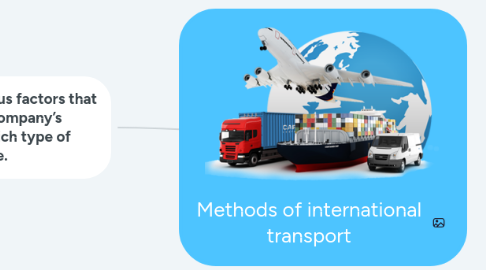
1. There are various factors that will influence company’s decision on which type of transport to use.
1.1. Air transport for international trade
1.1.1. Advantages
1.1.2. Deliver items quickly over long distances
1.1.3. Give high levels of security for sensitive items
1.1.4. Be used for a wide range of goods
1.1.5. Risks
1.1.6. Air transport can involve higher costs than other options.
1.1.7. Flights are subject to delay or cancellation
1.1.8. There are taxes to be paid in each airport
1.1.9. Fuel and currency surcharges will usually be added to freight costs
1.1.10. Further transportation may be needed from the airport to the final destination
1.2. Sea transport for international trade
1.2.1. Advantages
1.2.2. Possibility to ship large volumes at low costs
1.2.3. Shipping containers can also be used for further transportation by road or rail
1.2.4. Risks
1.2.5. shipping by sea can be slower than other transport systems.
1.2.6. routes and timetables are usually inflexible
1.2.7. tracking the goods’ progress is difficult
1.2.8. port duties and taxes
1.2.9. further transportation overland might be needed to reach the final destination
1.2.10. basic freight rates are subject to fuel and currency surcharges
1.3. Road transport for international trade
1.3.1. Advantages
1.3.2. Low cost
1.3.3. Extensive road networks
1.3.4. Possibility to schedule transport and tracking the location of goods
1.3.5. Safe and private delivery
1.3.6. Risks
1.3.7. long distances overland can take more time
1.3.8. there can be traffic delays and breakdowns
1.3.9. there is the risk of goods being damaged, especially over long distances
1.3.10. toll charges are high in some countries
1.3.11. different road and traffic regulations on some countries
1.4. Rail transport for international trade
1.4.1. Advantages
1.4.2. Rail transport is a cost-effective and efficient way to move goods.
1.4.3. Risks
1.4.4. routes and timetables available can be inflexible, especially in remote regions
1.4.5. can be more expensive than road transport
1.4.6. mechanical failure or industrial action can disrupt services
1.4.7. further transportation may be needed from a rail depot to the final destination, increasing costs and affecting delivery schedules
